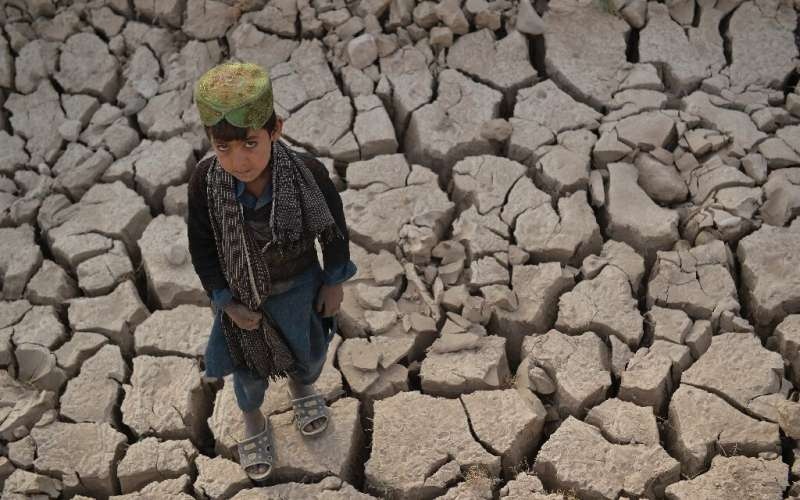A child stands on drought-riddled land in Badghis Province, Afghanistan (Hoshang Hashimi/AFP)
The chair of November’s COP26 climate change summit, UK minister Alok Sharma, declared, “For those countries most vulnerable to the impacts of climate change — who are already seeing their homes disappear under water and their crops decimated by drought — COP26 simply can’t be another talking shop.”
There was general acknowledgement at the summit that an effective response must include and support developing countries as well as the more developed. But, as many participants and observers noted, there was a shortage of specifics.
One of those was a recognition of conflict areas such as Afghanistan.
Drought and Hunger
In August, global attention briefly returned to Afghanistan with the takeover of the country by the Taliban. Much of the discussion revolved around if and how other countries would engage with the interim government amidst impending humanitarian disaster and economic collapse. That discourse centered
on the administrative system of the state and largely ignored the underlying influence of
climate change on Afghanistan’s economic, humanitarian, and political issues.
The country has suffered two droughts within four years because of a significant reduction in snow and
rainfall. Many in rural areas face shortages because of the high salinity of groundwater and the unavailability of potable water.
There is an absence of water management programmes to provide relief to the largely agrarian-based population. Outdated irrigation infrastructure is designed to accommodate less than 1/3 of people.
In the aftermath of the Taliban takeover, the UN declared that almost half the Afghan population faced acute hunger. This was only a continuation of the long-standing crisis. UNICEF’s 2018 situation report on Afghanistan explained that drought affected 3 million people and 6 million were food insecure. However, the situation deteriorated this year when the lack of rain ruined 40% of the wheat crop.
The impending winter brings with it little hope amid soaring fuel and food prices. The Executive Director of the World Food Programme, David Beasley, fears the planet’s worst humanitarian crisis as “23 million people march towards starvation”.
Last month a widowed mother of seven explained the desperation of her situation. Asked if she would consider selling her daughters for marriage, she answered yes — if it meant they could all survive.
What Is To Be Done?
Climate change’s impact is not just physical but political. The deprivation, especially in rural Afghanistan, sped the erosion of the state as it affected employment and poverty and contributed to migration. The Taliban seized upon dissatisfaction with the government in Kabul and people’s willingness to rely on any alternative.
But now the Taliban are the de facto government and, as the WFP’s Beasley notes, it is the group’s interest to try and prevent the starvation and deaths of millions of Afghans.
How can the Taliban respond? The Notre Dame Global Adaptation Initiative ranks Afghanistan
as the 12th-most vulnerable country ito climate change, and the 10th-least ready. The former climate change director at Afghanistan’s National Environmental Protection Agency, Samim Hoshmand, fears the limited achievements made in recent years will be unravelled. The agency has been closed and the financing of key projects is in jeopardy.
International engagement is critical. But the absence of Afghan representatives at COP26 was discouraging, as the UN rejected the applications of six of the country’s climate experts to attend. One of the specialists told The Guardian:
By taking this action the UNFCCC secretariat stifled the voice of millions of Afghan victims of climate change impact. Climate change does not respect borders. They should have not mixed the environment with politics. We were hoping to attend COP26 to raise the voice of millions of Afghan
victims of the adverse impacts of climate change.
In October, the US Agency for International Development announced a further $144 million in humanitarian aid to Afghanistan, for a total of $474 million in 2021. At the same time, the first-ever US National Intelligence Estimate on climate change and American national security cited Afghanistan as one of the leading countries of concern.
But money and intelligence do not necessarily portend future cooperation in tackling climate change. Aid distribution is still limited with the onset of winter. There is no clarity on the relationship with the Taliban.
Samantha Mort of UNICEF Afghanistan summarizes, referring to the millions of food-insecure children in the country, “There’s no childhood….It’s all about survival and getting through the next day.”


Trackbacks/Pingbacks